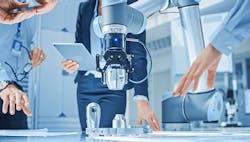What makes cobots the next-generation super power tool?
Industrial robots hit the 3-million-unit mark, averaging a 13% annual increase over the latter half of the 2010s. And that growth will continue exponentially.
Where we once thought of robots as machinery, their evolution has enhanced their capabilities as much as it’s commoditized their existence. Collaborative robots (cobots) have become a “next-generation super power tool,” says Mike Chen of Omron Automation. In my podcast conversation with him, Chen explains the many factors affecting automation innovation.
Also read: Integrated, intelligent and interactive technologies put the innovation in automation
“Transformation for robotic automation is picking up speed across traditional and new industries,” says Milton Guerry, president of the International Federation of Robotics (IFR). “More companies are realizing the numerous advantages robotics provides for their businesses.”
Segments new to automation are the ones adopting robots the fastest. There are thousands of robots installed worldwide that didn’t exist five years ago. To address labor shortages, companies are considering automation, especially for delivery and logistics, construction and agriculture.
Implementing robots can be a complex task, but robots have become easier to use. User interfaces allow icon-driven programming and manual guidance of robots, and hardware packages are bundled with software to ease implementation. The trend for low-cost robotics also comes with easy setup and installation, with specific applications pre-configured in some instances. Suppliers offer standard programs combined with grippers, sensors and controllers. And app stores provide program routines for various applications and support robot deployment.
The journey toward data-driven production lines focuses on education and training. Besides in-house training, robot manufacturers report registrations of around 20,000 participants in their classes across more than 30 countries every year, according to IFR.
These robotic training opportunities benefit manufacturers and their employees. Dull, dirty and dangerous tasks are automated, while people learn key skills for the industrial workplace of the future.
Record growth is also occurring in machine vision, motion control and motors. “The pandemic and the resulting disruptions to supply chains and labor availability appear to have been the push that many needed to justify the investment,” says Dr. Susanne Bieller, general secretary of the IFR. The next-generation super power tool has arrived.
Mike Bacidore is the editor in chief for Control Design magazine. He is an award-winning columnist, earning a Gold Regional Award and a Silver National Award from the American Society of Business Publication Editors. Email him at [email protected].
About the Author
Mike Bacidore
Editor in Chief
Mike Bacidore is chief editor of Control Design and has been an integral part of the Endeavor Business Media editorial team since 2007. Previously, he was editorial director at Hughes Communications and a portfolio manager of the human resources and labor law areas at Wolters Kluwer. Bacidore holds a BA from the University of Illinois and an MBA from Lake Forest Graduate School of Management. He is an award-winning columnist, earning multiple regional and national awards from the American Society of Business Publication Editors. He may be reached at [email protected]

Leaders relevant to this article:


